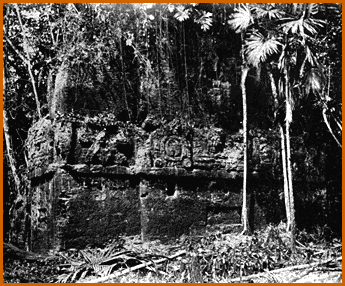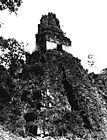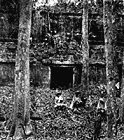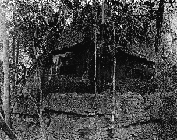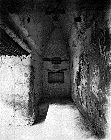| Therefore all important ruins in this
land are regarded as enchanted, encantadas |
| When I undertook the first expedition to Tikal in the middle of 1895, it was not with the expectation of working up this enormous city of ruins during a first visit, for such an undertaking could not be accomplished without considerable preparation; I only intended to reconnoitre the ground as thoroughly as possible, to make drawings and plans of the most important subjects, and to take photographs which did not require too much preliminary work. |

|
| On the 25th of May we embarked in a large cayuco obtained from the alcalde and rowed to the village of El Remate at the eastern end of the lake. As there was no wind our voyage was quickly and safely make along the beautiful wooded north shore for the most part. Owing to the calm weather we were able to avoid entering the great bays formed by the promontories, and could cross from cape to cape, thus saving much time and labor. In a storm it is absolutely necessary to hug the shore. |
| The repulsive malaches perpetrate on the water the very same iniquity which the smallest owl of Yucatan perpetrates on land. This little bird by way of a tidbit picks out the eyes of the beautiful ocellated turkeys (Meleagris ocellata) while they are innocently roosting at night on the branches of lofty trees. Indians, who accompanied me on my wanderings in the wildernesses of Yucatan, assured me that when out hunting they have occasionally found cuts straying helplessly about in the forest with their eyes pecked out, and dying of starvation. |
| On this expedition I already noticed that the waters of Lake Peten-Itza were in the process of rising, for at flat portions of the north shore I frequently observed dead trees standing far out in the water. |
| This aguada is about half-way between El Ramate and Tikal; it is surrounded by small heaps of debris and I also found a chultun or rain-well near by. However we continued on our way turning off far to the right, along the tops of a range of hills, at the end of which we spent the night, this time managing to get along with the water we had brought in the calabazos filled at the Ixpita aguada. Descending the range of hills we came to small heaps of ruins, and further on to much larger ones. Late in the afternoon of May 28, 1895, after a three days' march, we came out at Tikal, near the great Palace of the Grooved Walls, in the vicinity of which the Indians pitched their camp. Remaining with the baggage myself, I at once sent the men to the aguada with every available vessel, in order to lose no time in settling the question of water supply. |
| As we were already approaching the end of the dry season, the surface of the aguada proved to be quite dry, but a hole (un pozo) already dug by former travellers, was speedily deepened, until by good fortune the men struck water, which was still contained in the black soil; otherwise, parched with thirst we would have been obliged to retrace our steps the next day to the Ixpita aguada. On the following day I began the inspection of the ruins, intending to have the trees and shrubs cut away from those structures which I wished to photograph, when a great and unexpected difficulty arose. The men from San Jose whom I had brought with me were capable and willing enough on the water as oarsmen, and on land as carriers of burdens, but they were entirely unwilling to fell trees, and especially to excavate buried sculptures. |
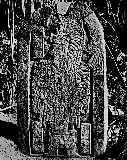
|

| A certain vicious fellow named Pedro Ek proved especially mutinous. He apparently had a bad influence upon the other men, whom he incited to refuse to work in order to hasten their return to San Jose. Not in the least inclined to have my work interfered with and my time wasted by this rapscallion, I withdrew from their camp and had my baggage, my provisions and a supply of water carried to the Two-storied Palace which stands opposite Great Temple V toward the north. The central north chamber of the first story with its niches and great stone benches affords the traveller many conveniences. |
| Therefore, during the eight days of my stay at Tikal, from May 25 to June 5, 1895, I drew the ground-plans of the five chief temples, also that of my Two-storied Palace and the Palace of Five Stories. I made careful tracings of all the most important of the best preserved incised drawings found on the smoothly stuccoed walls of the chambers in the different structures, for I had fortunately brought an ample supply of tracing paper with me. |
| Photographs were taken of a few of the best preserved edifices. The sculptured stones were not photographed at this time, since the preparation would have taken too much time. Taking it all in all, a fair share of work was thus accoplished, and my collection of incised mural drawings is altogether unequalled. To tell the truth, I somewhat overworked and felt a good deal exhausted each night. |
| When I am sleeping in solitude in a ruin or under a tree in the primeval forest, or in a little cave, I am not at all disturbed by the serenades tendered me at the midnight hour by the Felis onca, the Felis pardalis, the Felis concolor, or any of their kin. It always seems to me to be part of the situation, so I listen with cheerful attention. The darkness of the night makes no difference in my feelings, because I am convinced that the same amount of good and evil always exists whether our planet bears us in sunlight or shadow. |
| * Excerpted from Explorations in the Department of Peten, Guatemala: Tikal. Memoirs 5(1). Peabody Museum of American Archaeology and Ethnology, Harvard University, Cambridge, MA. (Maler 1911:3-6) |
